How to Integrate Microsoft Teams and Sharepoint?
Ever felt like using Microsoft Teams is great for communication, but when it comes to managing files and collaborating on content, things get a bit messy?
That's where integrating Microsoft Teams with SharePoint comes in.
When you combine Teams' real-time communication with SharePoint's document management features, it can create a great workspace for collaboration. In this blog, we'll explore three ways to integrate Teams and SharePoint to supercharge your teamwork.

What Is Microsoft Teams and Sharepoint Integration?
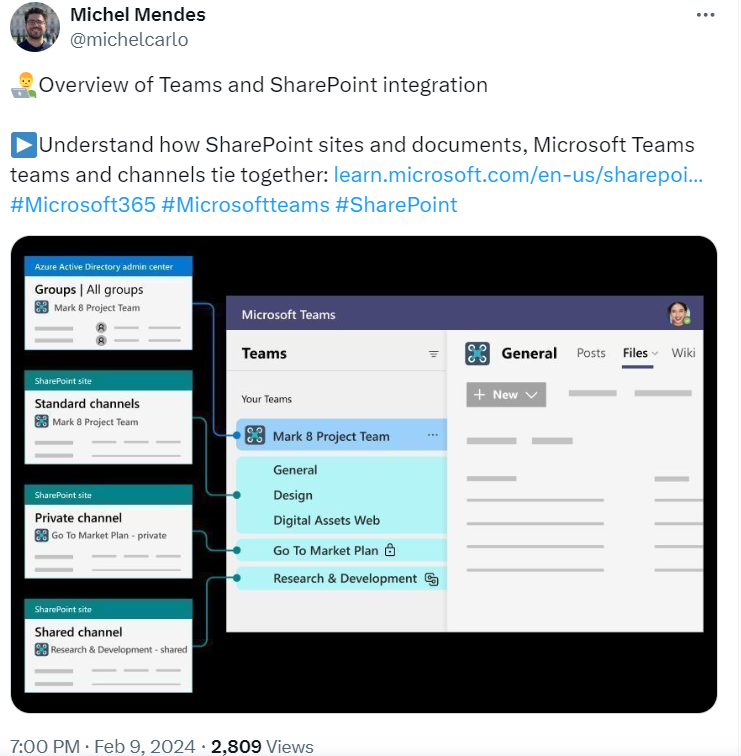
Imagine you're working on a project with your team, and you need to chat, share files, and have video calls all in one place. Well, that's where Microsoft Teams and SharePoint integration comes in handy!
Microsoft Teams is like your hub for real-time communication and collaboration. You can chat with your team, hop on video calls, and work together on projects seamlessly. It's like your virtual office where everything happens. On the other hand, SharePoint is where you create websites, publish content, and store files in a structured manner. It keeps everything neat, making it easy to find what you need when you need it.
When you integrate Teams and SharePoint, you can access all your SharePoint documents and libraries directly within Teams channels. So, whether you're chatting with your team or having a video meeting, you can easily pull up files and collaborate without switching between apps.
Connecting and Integrating Teams and Sharepoint
I think the biggest misconception people have is that Teams does everything itself—all the file storage, and if you’re using videos, it does all the video storage and all that sort of stuff. A lot of organizations think they can roll out Teams without rolling out SharePoint, and that’s obviously not the case.
— Michal Pisarek, Microsoft MVP and CEO of Orchestry Software
Let's dive into how teams can blend Microsoft Teams and SharePoint to supercharge collaboration and get the most out of both platforms:
Assessment and Planning
Before you start integrating SharePoint with Microsoft Teams, you've got to do your homework. First, catalog all your SharePoint sites, figure out what kind of content you've got floating around, and take a look at any advanced features or setups you've got going on. Once you've got the lay of the land, assess the costs and efforts involved in the integration process.
Developing a cost-benefit analysis is key. You want to know if the integration is worth it for your business. Will it save you time? Money? Make your team more productive. These are the questions you need to answer before making any big moves.
3 Techniques for Microsoft Teams and Sharepoint Integration
Businesses can employ various techniques to integrate SharePoint and Teams based on their requirements. These techniques include the following:
- You can pull content from your SharePoint sites directly into Teams using the "Website" app for Teams.
- If you've got old-school SharePoint sites hanging around, you can migrate all that content over to Teams.
- You can add Teams to your existing SharePoint sites using the "Add a Microsoft Team" capability.
1. Pulling Content with the Website App
Goal: To access SharePoint pages directly within Microsoft Teams without needing to switch applications.
Suppose you're in Teams, and you need quick access to some SharePoint pages without jumping between apps. Well, that's where the Teams "Website" app helps.
With this app, you can display all your web-based content, including those SharePoint pages, right within the Teams interface. You don't have to ditch your existing tech setup.
So, how do you set it up?
Step 1. Within Microsoft Teams, choose the channel where you want the SharePoint content to be accessible.
Step 2. Use the "Website" app within Teams to add a new tab.
Step 3. Copy and paste the URL of the SharePoint page you want to access into the Website app configuration.
Step 4. The SharePoint page will be available as a tab within the selected Teams channel, allowing you and your team to view and interact with the SharePoint content directly in Teams.
2. Migrating Content from Legacy SharePoint Sites
Goal: To transfer documents and their associated metadata and permissions from an old SharePoint site to Teams.
When your organization's got tons of important documents stored in SharePoint and you have to bring everything into Teams, Microsoft SharePoint Migration Tool eases transferring your documents from SharePoint to Teams. They keep all your metadata and permissions intact so you don't lose any crucial info in the move.
Now, how does it work?
Step 1. Set up the Microsoft SharePoint Migration Tool on your computer or server.
Step 2. Configure the migration tool, specifying what content you want to transfer and how you want it organized in Teams.
Step 3. Select the specific documents or folders you wish to migrate.
Step 4. Start the migration process using the tool, which will then transfer your selected SharePoint content to the appropriate Teams location.

3. Adding Teams to SharePoint Sites
Goal: To integrate a Microsoft Teams workspace with an existing SharePoint site, allowing users to collaborate on documents stored in SharePoint directly through Teams.
Adding a Microsoft Team to your existing SharePoint sites helps you create a workspace where users can access all their SharePoint documents right within Teams channels. But here's the thing: as you're mixing SharePoint and Teams, it can get a bit tricky for users to use at first.
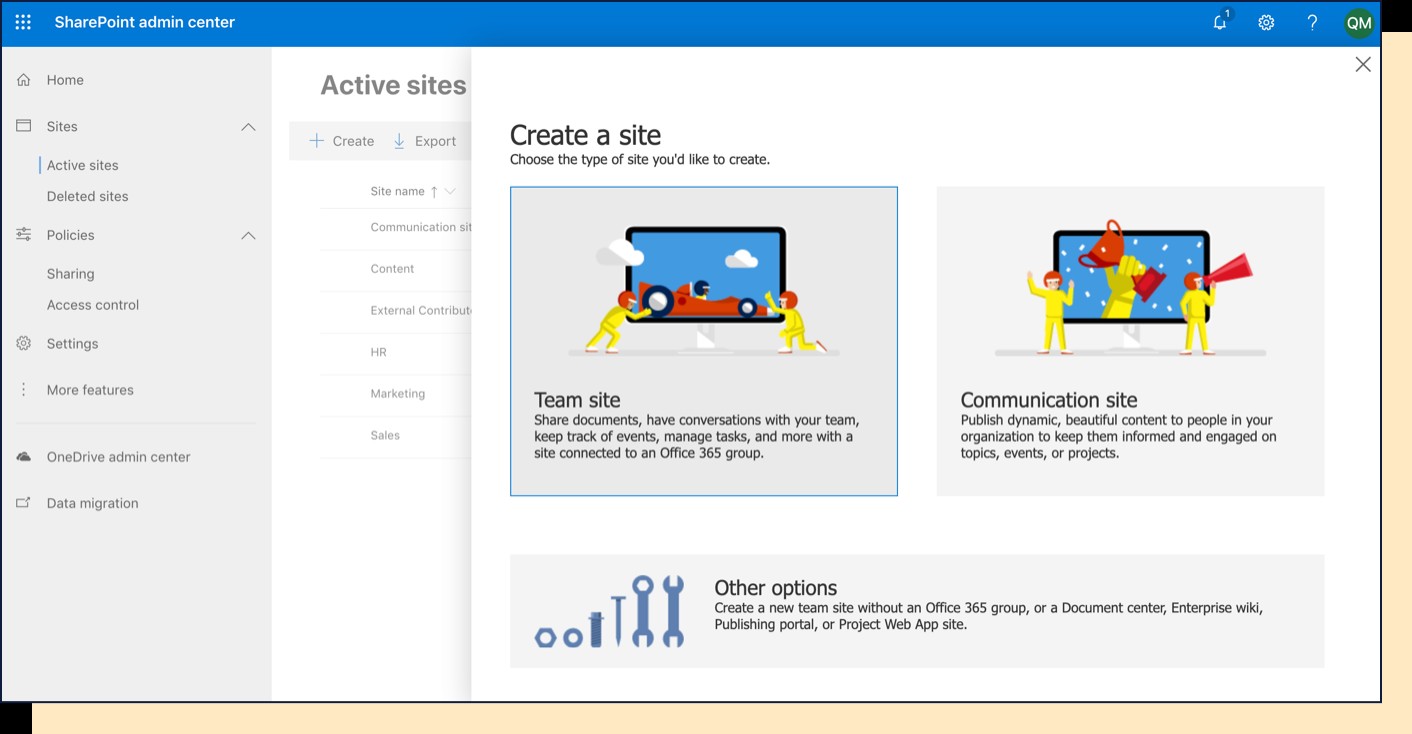
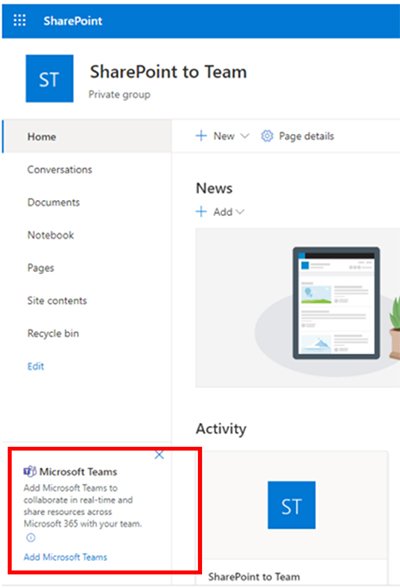

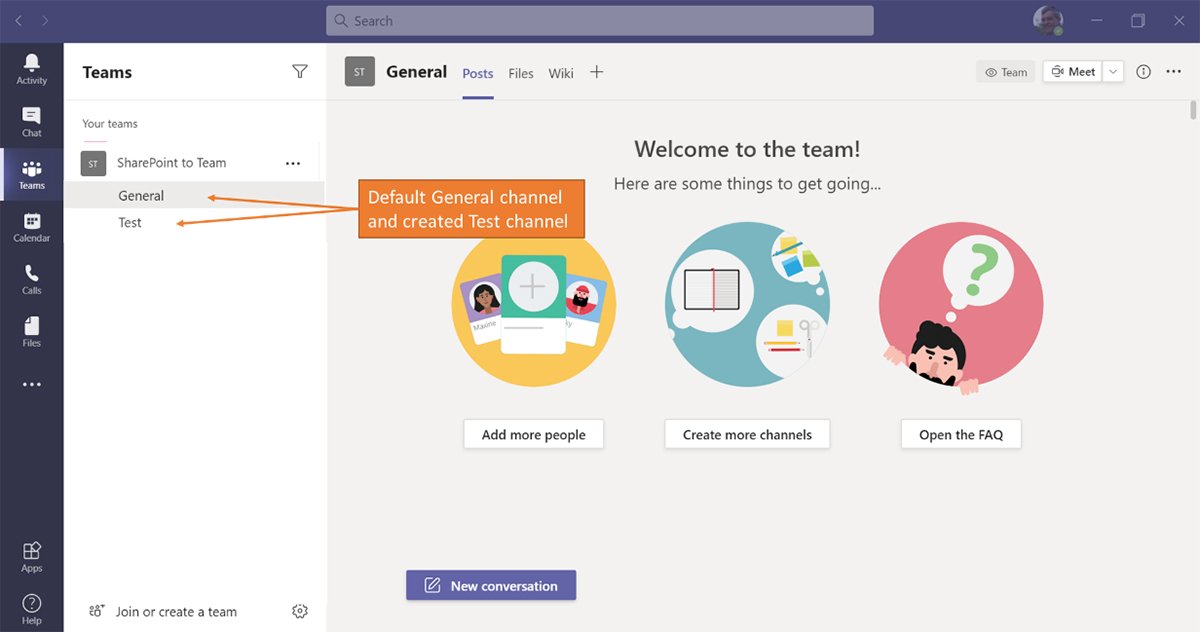
To make this integration as smooth as possible, organizations can use the "Add a Microsoft Team" button in SharePoint Online. Just follow the prompts, and before you know it, you'll have a unified workspace that's ready for collaboration.
Follow these steps:
Step 1. Go to your SharePoint Online site where the documents are stored.
Step 2. Look for and click the "Add a Microsoft Team" option, usually available in the site or settings menu.
Step 3. Follow the on-screen prompts to set up the integration, which might include naming your team, configuring permissions, and selecting the content you want to be accessible in Teams.
Step 4. Once setup is complete, your SharePoint site will be linked with a new or existing Team, making it easier for users to access and collaborate on documents within Teams.
Still unsure how to integrate Microsoft Teams with SharePoint? Watch the video tutorial given below:
Why Should Companies Do It?
Integrating SharePoint and Teams gives you smoother communication, better content management, and simplified access control—all in one neat package.
1. Improving Collaboration and Accessibility
Suppose you're working on a project with your team, and you need to share files, chat about ideas, and stay on top of everything. Integrating SharePoint and Teams makes all that happen smoothly!
If you've got a simple SharePoint site where you keep all your files and collaborate on documents, integrating with Teams can help you access those files directly within your Teams channels. This smooth integration means you can collaborate efficiently, whether you're working from home, in the office, or on the go.
2. Simplified Permissions Management
If an organization is deploying Teams, I would encourage your users to use Teams as that main entry point into the rest of Microsoft 365. You don’t really need to tell your users where that stuff is stored, and they don’t really care. I think as long as they can get access to their documents—and they can through Teams—then I think they’re really happy.
— Michal Pisarek, Microsoft MVP and CEO of Orchestry Software
With the integration of Microsoft 365 and Teams, SharePoint admins can use Microsoft 365 Groups memberships to handle permissions. Moreover, Teams channel owners can manage SharePoint access directly within Teams. This way, you're making sure that only the right people have access to the right stuff, improving security and peace of mind for everyone involved.
How to Stay Vigilant About Complex SharePoint Environments?
When integrating SharePoint with Teams, not all sites are created equal. Simple SharePoint sites can slide right into Teams easily.
But when you're dealing with complex environments – you need to tread carefully. These include SharePoint sites with intricate workflows, custom web parts, and more.
So, before you start moving these complex sites over to Teams, you've got to stop and think.
- Is it worth the effort and cost?
- Will it simplify things for your users?
- Or will it just add more complexity to the mix?
So, take a step back, evaluate the situation, and weigh the pros and cons.
DOs and DON’Ts of Teams and Sharepoint Integration
When it comes to integrating Teams and SharePoint, following dos and don'ts ensures a smooth transition. So, stick to the following rules to get the most out of your collaboration tools.
DOs of Teams and Sharepoint Integration
- Recognize constraints such as document library size limits and user sync limits to set realistic expectations and ensure you're making the most of what SharePoint has to offer.
- Maximize the out-of-the-box functionality of SharePoint. This means using all the amazing features that come standard with SharePoint without getting too fancy with customization. Not only does it save you money and time, but it also eases maintenance.
- SharePoint has its own unique architecture and features, so it's important to give your team the lowdown. Teach them about document libraries, metadata, and content types so they can navigate SharePoint like a pro.
- Utilize metadata and content types to standardize naming conventions and organize content efficiently. Metadata enhances search capabilities and facilitates retention and records management.
- Before you start migrating content, take some time to think about how you want things structured. Consider different site types, privacy settings, and how SharePoint will integrate with tools like Microsoft Teams.
- To take your workflow automation and app development to the next level in complex environments, you can make the most of Power Automate and Power Apps. Power Automate helps with workflow automation. It is beneficial over SharePoint's old-school workflow engines, making everything run smoother and faster.
- Use Power Apps. It is a low-code development platform that lets you create mobile apps in no time without needing to be a coding expert. Note that administrators should take a good look at these tools to see if they're a good fit for their SharePoint and Teams integration.
DON’Ts of Teams and Sharepoint Integration
- Don't just use SharePoint as a glorified file share. Sure, it's tempting to dump all your files in there and call it a day, but you'd be missing out on so much more. Take some time to explore its full capabilities before you start migrating content.
- Don't get into SharePoint and Teams without a proper plan in place. SharePoint has a lot going on under the hood, with sites, libraries, pages, and channels to consider. Without a powerful information architecture guiding your deployment, you could end up with a mess that's hard to navigate.
- Establish clear rules and guidelines for SharePoint usage to ensure consistency, security, and compliance, such as document policies regarding external sharing, permissible content, branding standards, and metadata/content types across the tenant to maintain a well-managed SharePoint environment.
The Role of GenAI in Teams-SharePoint Integration
When you integrate Teams and SharePoint, you're creating one spot for all your collaboration needs.
But what if you could also integrate Teams and SharePoint with an AI copilot?
Simplifying Complexity
Generative AI can decode complex integration requirements, making it easier for IT teams to tailor solutions.
Automated Support
It offers automated support, answering queries about Teams and SharePoint, reducing the workload on IT teams.
Learning and Adapting
The AI learns from interactions, improving its ability to support and guide users over time.
Wrapping Up as Enjo Enters
This is where Enjo steps in — it helps with the support queries and questions posted on Teams, it can be trained using your IT support data and documents, and it easily syncs with your Sharepoint sites!
Automated Answers
Enjo provides immediate, automated answers to common questions about using Teams and SharePoint, directly within the Teams environment.
Customized Learning
It learns from your organization's specific documents and support data, ensuring tailored and relevant responses.
Integration Made Easy
Enable a smoother integration process by connecting Enjo with Teams, where support is just a message away. Enjo makes this integration more intuitive by leveraging generative AI.
It not only facilitates smoother integration but also enhances the overall user experience, making digital collaboration more effective and enjoyable for everyone involved.
How to Connect Enjo with Your Teams App?
1. Add Enjo to your specific team in Microsoft Teams
2. Sign in to the Enjo platform
3. Connect your knowledge sources, ticketing systems, and apps
4. Ask Enjo questions from Teams channels
Here’s a glimpse:
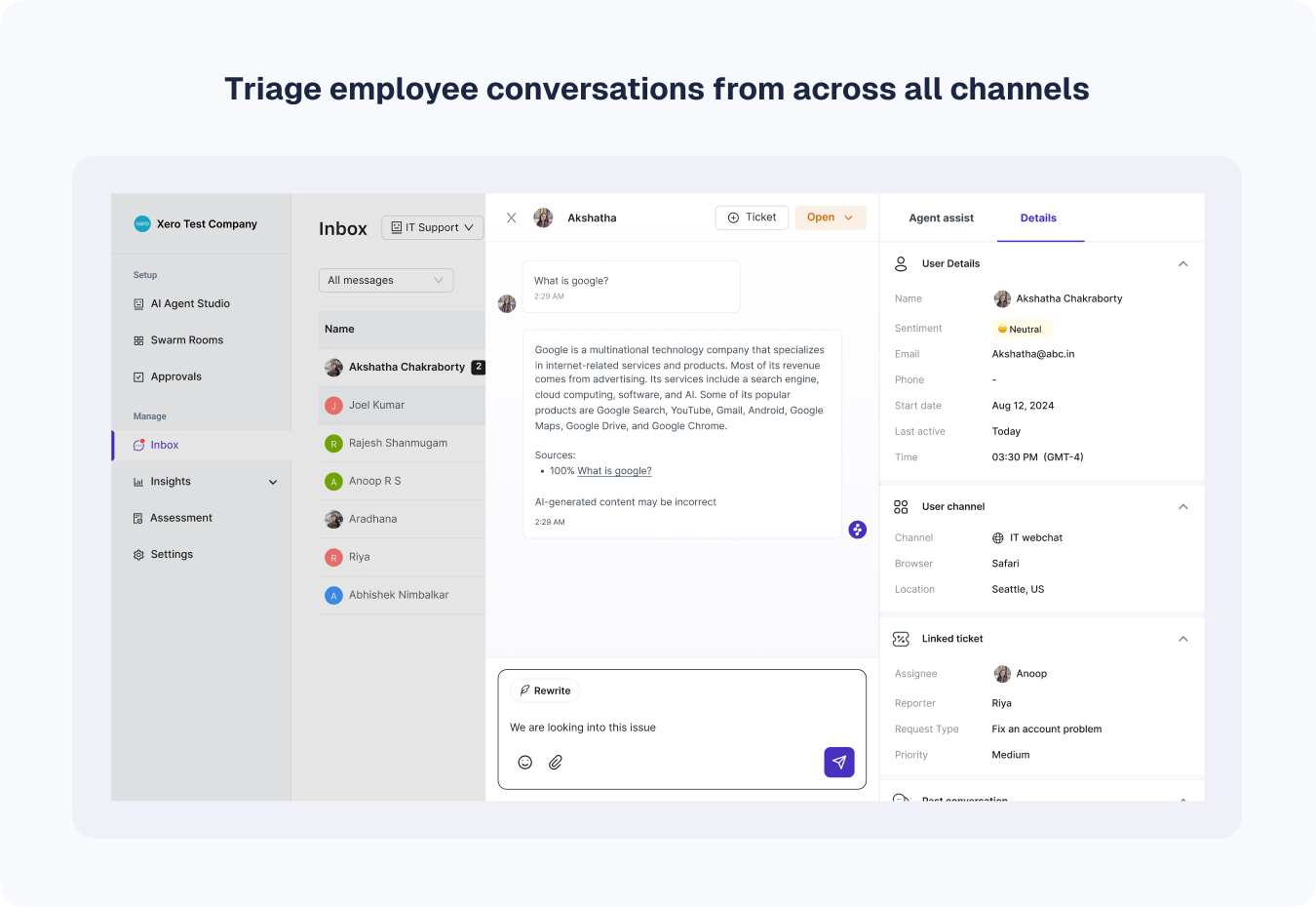

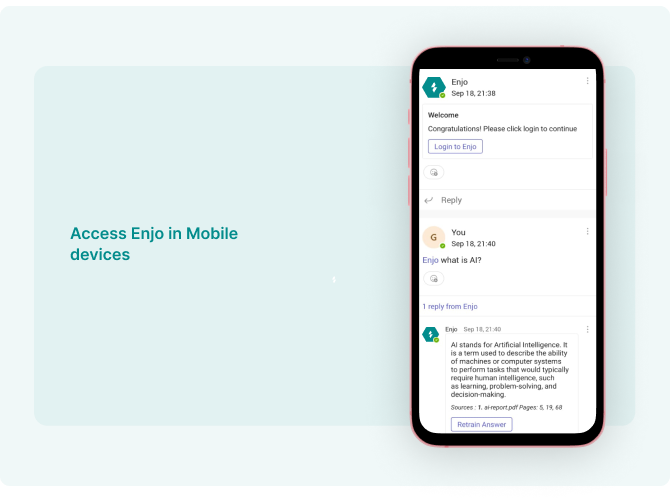
Sign up for a personalized demo and activate your free trial now!

What Is Microsoft Teams and Sharepoint Integration?

Imagine you're working on a project with your team, and you need to chat, share files, and have video calls all in one place. Well, that's where Microsoft Teams and SharePoint integration comes in handy!
Microsoft Teams is like your hub for real-time communication and collaboration. You can chat with your team, hop on video calls, and work together on projects seamlessly. It's like your virtual office where everything happens. On the other hand, SharePoint is where you create websites, publish content, and store files in a structured manner. It keeps everything neat, making it easy to find what you need when you need it.
When you integrate Teams and SharePoint, you can access all your SharePoint documents and libraries directly within Teams channels. So, whether you're chatting with your team or having a video meeting, you can easily pull up files and collaborate without switching between apps.
Connecting and Integrating Teams and Sharepoint
I think the biggest misconception people have is that Teams does everything itself—all the file storage, and if you’re using videos, it does all the video storage and all that sort of stuff. A lot of organizations think they can roll out Teams without rolling out SharePoint, and that’s obviously not the case.
— Michal Pisarek, Microsoft MVP and CEO of Orchestry Software
Let's dive into how teams can blend Microsoft Teams and SharePoint to supercharge collaboration and get the most out of both platforms:
Assessment and Planning
Before you start integrating SharePoint with Microsoft Teams, you've got to do your homework. First, catalog all your SharePoint sites, figure out what kind of content you've got floating around, and take a look at any advanced features or setups you've got going on. Once you've got the lay of the land, assess the costs and efforts involved in the integration process.
Developing a cost-benefit analysis is key. You want to know if the integration is worth it for your business. Will it save you time? Money? Make your team more productive. These are the questions you need to answer before making any big moves.
3 Techniques for Microsoft Teams and Sharepoint Integration
Businesses can employ various techniques to integrate SharePoint and Teams based on their requirements. These techniques include the following:
- You can pull content from your SharePoint sites directly into Teams using the "Website" app for Teams.
- If you've got old-school SharePoint sites hanging around, you can migrate all that content over to Teams.
- You can add Teams to your existing SharePoint sites using the "Add a Microsoft Team" capability.
1. Pulling Content with the Website App
Goal: To access SharePoint pages directly within Microsoft Teams without needing to switch applications.
Suppose you're in Teams, and you need quick access to some SharePoint pages without jumping between apps. Well, that's where the Teams "Website" app helps.
With this app, you can display all your web-based content, including those SharePoint pages, right within the Teams interface. You don't have to ditch your existing tech setup.
So, how do you set it up?
Step 1. Within Microsoft Teams, choose the channel where you want the SharePoint content to be accessible.
Step 2. Use the "Website" app within Teams to add a new tab.
Step 3. Copy and paste the URL of the SharePoint page you want to access into the Website app configuration.
Step 4. The SharePoint page will be available as a tab within the selected Teams channel, allowing you and your team to view and interact with the SharePoint content directly in Teams.
2. Migrating Content from Legacy SharePoint Sites
Goal: To transfer documents and their associated metadata and permissions from an old SharePoint site to Teams.
When your organization's got tons of important documents stored in SharePoint and you have to bring everything into Teams, Microsoft SharePoint Migration Tool eases transferring your documents from SharePoint to Teams. They keep all your metadata and permissions intact so you don't lose any crucial info in the move.
Now, how does it work?
Step 1. Set up the Microsoft SharePoint Migration Tool on your computer or server.
Step 2. Configure the migration tool, specifying what content you want to transfer and how you want it organized in Teams.
Step 3. Select the specific documents or folders you wish to migrate.
Step 4. Start the migration process using the tool, which will then transfer your selected SharePoint content to the appropriate Teams location.

3. Adding Teams to SharePoint Sites
Goal: To integrate a Microsoft Teams workspace with an existing SharePoint site, allowing users to collaborate on documents stored in SharePoint directly through Teams.
Adding a Microsoft Team to your existing SharePoint sites helps you create a workspace where users can access all their SharePoint documents right within Teams channels. But here's the thing: as you're mixing SharePoint and Teams, it can get a bit tricky for users to use at first.




To make this integration as smooth as possible, organizations can use the "Add a Microsoft Team" button in SharePoint Online. Just follow the prompts, and before you know it, you'll have a unified workspace that's ready for collaboration.
Follow these steps:
Step 1. Go to your SharePoint Online site where the documents are stored.
Step 2. Look for and click the "Add a Microsoft Team" option, usually available in the site or settings menu.
Step 3. Follow the on-screen prompts to set up the integration, which might include naming your team, configuring permissions, and selecting the content you want to be accessible in Teams.
Step 4. Once setup is complete, your SharePoint site will be linked with a new or existing Team, making it easier for users to access and collaborate on documents within Teams.
Still unsure how to integrate Microsoft Teams with SharePoint? Watch the video tutorial given below:
Why Should Companies Do It?
Integrating SharePoint and Teams gives you smoother communication, better content management, and simplified access control—all in one neat package.
1. Improving Collaboration and Accessibility
Suppose you're working on a project with your team, and you need to share files, chat about ideas, and stay on top of everything. Integrating SharePoint and Teams makes all that happen smoothly!
If you've got a simple SharePoint site where you keep all your files and collaborate on documents, integrating with Teams can help you access those files directly within your Teams channels. This smooth integration means you can collaborate efficiently, whether you're working from home, in the office, or on the go.
2. Simplified Permissions Management
If an organization is deploying Teams, I would encourage your users to use Teams as that main entry point into the rest of Microsoft 365. You don’t really need to tell your users where that stuff is stored, and they don’t really care. I think as long as they can get access to their documents—and they can through Teams—then I think they’re really happy.
— Michal Pisarek, Microsoft MVP and CEO of Orchestry Software
With the integration of Microsoft 365 and Teams, SharePoint admins can use Microsoft 365 Groups memberships to handle permissions. Moreover, Teams channel owners can manage SharePoint access directly within Teams. This way, you're making sure that only the right people have access to the right stuff, improving security and peace of mind for everyone involved.
How to Stay Vigilant About Complex SharePoint Environments?
When integrating SharePoint with Teams, not all sites are created equal. Simple SharePoint sites can slide right into Teams easily.
But when you're dealing with complex environments – you need to tread carefully. These include SharePoint sites with intricate workflows, custom web parts, and more.
So, before you start moving these complex sites over to Teams, you've got to stop and think.
- Is it worth the effort and cost?
- Will it simplify things for your users?
- Or will it just add more complexity to the mix?
So, take a step back, evaluate the situation, and weigh the pros and cons.
DOs and DON’Ts of Teams and Sharepoint Integration
When it comes to integrating Teams and SharePoint, following dos and don'ts ensures a smooth transition. So, stick to the following rules to get the most out of your collaboration tools.
DOs of Teams and Sharepoint Integration
- Recognize constraints such as document library size limits and user sync limits to set realistic expectations and ensure you're making the most of what SharePoint has to offer.
- Maximize the out-of-the-box functionality of SharePoint. This means using all the amazing features that come standard with SharePoint without getting too fancy with customization. Not only does it save you money and time, but it also eases maintenance.
- SharePoint has its own unique architecture and features, so it's important to give your team the lowdown. Teach them about document libraries, metadata, and content types so they can navigate SharePoint like a pro.
- Utilize metadata and content types to standardize naming conventions and organize content efficiently. Metadata enhances search capabilities and facilitates retention and records management.
- Before you start migrating content, take some time to think about how you want things structured. Consider different site types, privacy settings, and how SharePoint will integrate with tools like Microsoft Teams.
- To take your workflow automation and app development to the next level in complex environments, you can make the most of Power Automate and Power Apps. Power Automate helps with workflow automation. It is beneficial over SharePoint's old-school workflow engines, making everything run smoother and faster.
- Use Power Apps. It is a low-code development platform that lets you create mobile apps in no time without needing to be a coding expert. Note that administrators should take a good look at these tools to see if they're a good fit for their SharePoint and Teams integration.
DON’Ts of Teams and Sharepoint Integration
- Don't just use SharePoint as a glorified file share. Sure, it's tempting to dump all your files in there and call it a day, but you'd be missing out on so much more. Take some time to explore its full capabilities before you start migrating content.
- Don't get into SharePoint and Teams without a proper plan in place. SharePoint has a lot going on under the hood, with sites, libraries, pages, and channels to consider. Without a powerful information architecture guiding your deployment, you could end up with a mess that's hard to navigate.
- Establish clear rules and guidelines for SharePoint usage to ensure consistency, security, and compliance, such as document policies regarding external sharing, permissible content, branding standards, and metadata/content types across the tenant to maintain a well-managed SharePoint environment.
The Role of GenAI in Teams-SharePoint Integration
When you integrate Teams and SharePoint, you're creating one spot for all your collaboration needs.
But what if you could also integrate Teams and SharePoint with an AI copilot?
Simplifying Complexity
Generative AI can decode complex integration requirements, making it easier for IT teams to tailor solutions.
Automated Support
It offers automated support, answering queries about Teams and SharePoint, reducing the workload on IT teams.
Learning and Adapting
The AI learns from interactions, improving its ability to support and guide users over time.
Wrapping Up as Enjo Enters
This is where Enjo steps in — it helps with the support queries and questions posted on Teams, it can be trained using your IT support data and documents, and it easily syncs with your Sharepoint sites!
Automated Answers
Enjo provides immediate, automated answers to common questions about using Teams and SharePoint, directly within the Teams environment.
Customized Learning
It learns from your organization's specific documents and support data, ensuring tailored and relevant responses.
Integration Made Easy
Enable a smoother integration process by connecting Enjo with Teams, where support is just a message away. Enjo makes this integration more intuitive by leveraging generative AI.
It not only facilitates smoother integration but also enhances the overall user experience, making digital collaboration more effective and enjoyable for everyone involved.
How to Connect Enjo with Your Teams App?
1. Add Enjo to your specific team in Microsoft Teams
2. Sign in to the Enjo platform
3. Connect your knowledge sources, ticketing systems, and apps
4. Ask Enjo questions from Teams channels
Here’s a glimpse:



Sign up for a personalized demo and activate your free trial now!


Accelerate support with Generative AI


Stay Informed and Inspired














